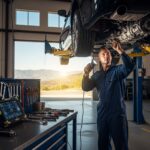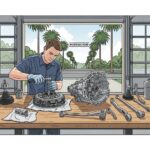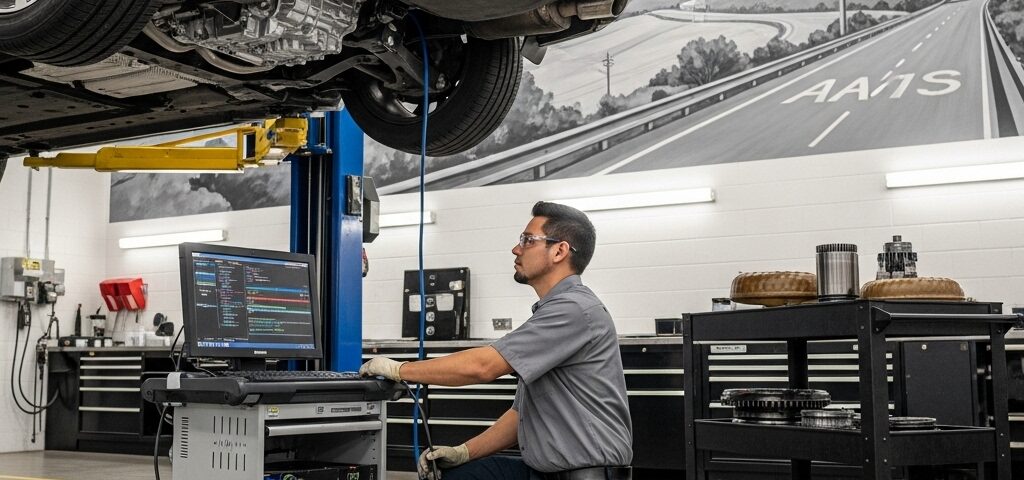
Transmission Repair Near Me in Thousand Oaks California
October 5, 2025
Manual Transmission Repair Specialists in Thousand Oaks California
October 5, 2025Automatic transmissions are the quiet negotiators of every Thousand Oaks drive—sliding you onto the 101 at dawn, smoothing out the stoplights along Thousand Oaks Boulevard, and settling into an effortless cruise past Wildwood and Westlake. When they work, you barely notice them; when they falter, the rhythm of daily life changes. That’s why turning to a nearby team of automatic specialists matters. From torque converter behavior to shift mapping, modern automatics demand trained eyes and steady hands. And if you’ve been searching for help, there’s no substitute for a local shop that knows our roads and our routines, one that can guide you toward confident, reliable transmission repair without detours or guesswork.
What makes automatic transmissions unique
Unlike manuals, automatics manage an intricate dance between hydraulic pressure, clutches, bands, and electronic controls. Many newer vehicles add continuously variable transmissions, dual-clutch units, or multi-speed automatics with sophisticated logic. Each type brings strengths and quirks. A torque converter, for example, needs healthy fluid and appropriate lockup strategy to deliver smooth, efficient acceleration. Valve bodies must respond precisely to throttle inputs, and the transmission control module must interpret data from sensors scattered around the powertrain. When something feels off—say, a late upshift leaving the Janss Marketplace or a hunting gear on the steady legs of the 101—pinpointing the cause requires methodical testing, not assumptions.
The Thousand Oaks factor
Our local driving mix provides both challenges and advantages for diagnostics. City streets north of the Civic Arts Plaza are perfect for light-throttle shift checks. The 23’s grades test behavior under load, and the long, flat stretch toward Camarillo provides a clean window to evaluate torque converter lockup and cruising stability. Warm summer afternoons reveal heat-related quirks that cool mornings might hide. A seasoned technician uses these conditions to see how the transmission behaves across its full operating spectrum, then translates observations into accurate conclusions.
Listening before scanning
The best assessments start with your description. Do shifts flare when pulling out of Newbury Park? Does a shudder appear only after twenty minutes on the highway? Does the issue respect temperature or throttle? These details help define the test path. After the conversation comes inspection: fluid check, connector integrity, external leaks, and any obvious wear. Then scanning begins. Live data—line pressure commands, shift solenoid activity, clutch duty cycles—tells a story when paired with how the vehicle feels. Good diagnosis doesn’t rely on a single clue; it braids your observations with measurements and road behavior until the pattern is unmistakable.
Common automatic concerns and what they mean
Drivers often report delayed engagement when selecting drive or reverse, particularly after the car has been parked at The Oaks for a couple of hours. Others notice a 2–3 upshift that feels inconsistent or a torque converter lockup that seems to pulse at a steady cruise. These symptoms can point to varied causes: fluid past its prime, a solenoid that’s growing lazy, a valve body with small passage wear, or control software that needs recalibration. The value of a specialized shop is separating what’s normal adaptation from what’s a true fault, ensuring solutions are precise rather than overbroad.
Maintenance that protects modern automatics
Healthy fluid is the lifeblood of an automatic transmission. It carries heat away, lubricates critical surfaces, and enables clutch engagement. In a climate like ours, fluid that’s overstressed by repeated hill climbs or long highway pulls can lose some of its protective qualities. Regular checks are not about following a generic interval; they’re about verifying real condition. A good shop will show you what they see, explain the implications, and recommend a maintenance rhythm that aligns with your driving—commuting to Westlake offices, weekend trips toward Ventura, or a mix of both.
When software matters as much as hardware
Many late-model automatics can adapt shift quality over time. That’s helpful, but it can also mask early issues. A technician who understands your transmission’s logic can determine whether software is compensating for a developing mechanical concern, or if a reset and adaptation drive might restore crisp shifts. In some cases, a focused software update and a structured drive cycle through Thousand Oaks roads will bring the system back into harmony without further intervention.
The power of a proper road test
Precision diagnosis requires a thoughtful route. A technician might begin along Moorpark Road at light throttle, then increase load up the 23 to monitor pressure targets. A steady cruise on the 101 toward Westlake Village helps evaluate torque converter lockup and gear holding strategy. Returning through city streets verifies downshift smoothness and creep behavior at parking-lot speeds. The goal is to recreate your symptom in a controlled way, correlate it with data, and isolate the root cause. It’s careful work, and it’s where true expertise shines.
Mid-guide reminder: act on what you feel
If you recognize your vehicle in these descriptions—a flare, a shudder, a late shift—the next step is simple. Make note of when and where it happens, then schedule a visit. Experienced help is nearby, and clear, practical answers are the norm when the problem is approached methodically. When it’s time to take that step, choose proven local transmission repair so your car gets the attention it deserves and you get the clarity you need.
Repair, service, or overhaul—what’s right?
There is no one-size solution. Some vehicles benefit from targeted fixes, like addressing a specific solenoid or valve body concern. Others respond to maintenance and recalibration. In more involved cases, wear across multiple components suggests a comprehensive plan. The decision is informed by data, test results, and your goals for the vehicle. If the car is your everyday partner on the school run and your weekend companion up to the Santa Monica Mountains, reliability may be your north star. A good shop will keep that priority front and center.
Why local relationships matter
Automatic transmissions are intricate, and follow-up is part of excellence. Having a shop nearby means quick check-ins after a repair, easy second looks if a small quirk appears, and steady communication during the process. That proximity, paired with a technician’s familiarity with Thousand Oaks traffic and terrain, shortens the path to lasting results. In a community where schedules are busy and expectations are high, that level of service is more than a luxury; it’s the practical way to keep your car at its best.
Preparing for your appointment
Before you visit, gather details. When did the symptom begin? Is it tied to temperature, slope, speed, or throttle? Have you had any recent engine work that might influence shift quality? If you can reproduce the concern near specific landmarks—say, during the climb up the Conejo Grade—mention that. The more precise your notes, the faster the diagnostic path, and the more accurate the solution.
How to drive kindly to your automatic
Support your transmission with simple habits. Ease into the first few minutes of driving, especially on cool mornings. Come to a full stop before selecting reverse or drive in crowded lots around The Oaks. On longer grades, consider using manual mode if available to prevent lugging or constant gear hunting. After extended highway runs, allow the vehicle to idle briefly before shutting down on hot days. None of these steps take extra time; they simply give your transmission what it needs to thrive.
Confidence through communication
What most drivers want is straightforward, jargon-free explanations. A specialized automatic transmission team will show you what’s verified, what’s likely, and what can be ruled out. You’ll understand why a recommendation is made and how it aligns with your driving. That transparency turns an uncertain situation into a plan, and it’s the hallmark of expert-level service.
Frequently asked questions
Why does my car hesitate before engaging drive?
Delayed engagement can indicate fluid condition concerns, pressure loss, or wear in specific components. It’s also temperature-sensitive. A focused inspection that includes cold and warm checks, plus a road test, will separate normal adaptation from a true problem.
Is a shudder at steady highway speed always the torque converter?
Not always. It could be converter-related, but it can also stem from software behavior, ignition or engine issues felt through the drivetrain, or a valve body concern. Diagnosis compares how the car feels with live data to determine the exact cause.
Can a software reset fix rough shifts?
Sometimes. If the transmission has adapted around a change in driving style or a minor issue, a reset followed by a structured adaptation drive can help. If there’s mechanical wear, software alone won’t resolve it, but it may clarify what’s going on.
How often should automatic transmission fluid be checked?
Check intervals differ by vehicle and driving pattern. In Thousand Oaks, where we mix highway cruises with hill climbs, evaluating condition rather than following a generic mileage target is best. A brief inspection during routine service keeps you ahead of surprises.
What if the problem only happens once in a while?
Intermittent symptoms are common. A technician can design a test route to recreate them, using terrain and temperature changes to bring the behavior to the surface. Your notes about when it appears are invaluable for this process.
Do I need a full rebuild if my transmission slips?
Not necessarily. Slipping can have multiple causes. The right next step depends on test results. Some vehicles need targeted repairs; others require broader work. An evidence-based approach ensures you do only what’s necessary to restore reliability.
Will a nearby shop really make a difference?
Absolutely. Proximity means faster diagnostics, easier follow-ups, and road tests on familiar routes that reveal issues quickly. It also means you can pop in for a quick recheck without rearranging your day.
Speak with an automatic transmission expert today
Your car deserves the attention of specialists who drive the same roads you do and understand how our local conditions influence modern automatics. If you’ve noticed a hesitation, shudder, or shift that doesn’t feel quite right, let an expert team guide you to answers and restore that effortless glide through Thousand Oaks. Schedule trusted transmission repair today and enjoy every mile with renewed confidence.


